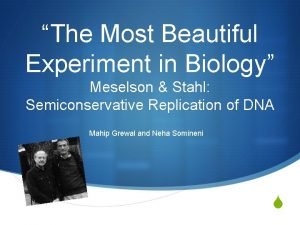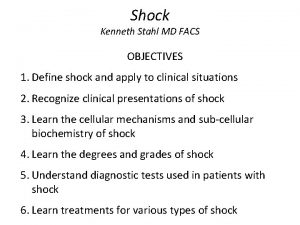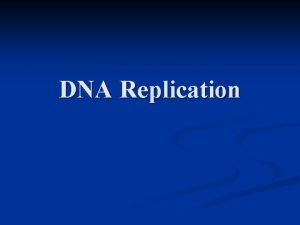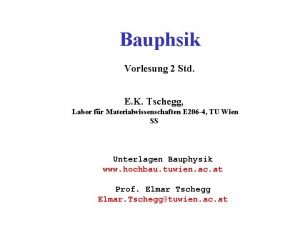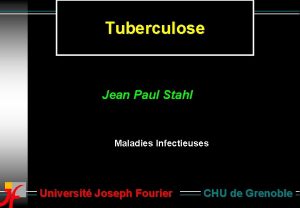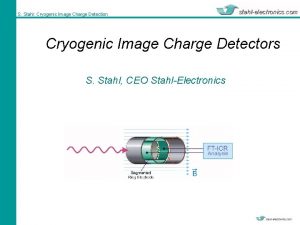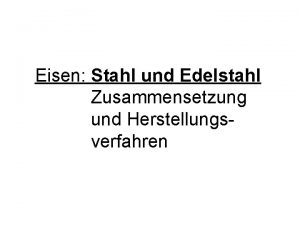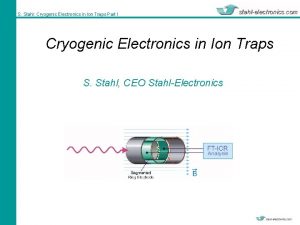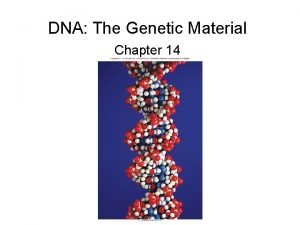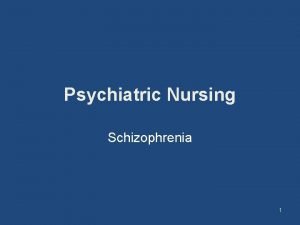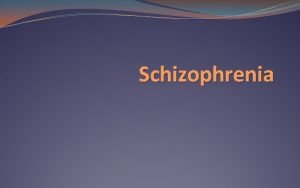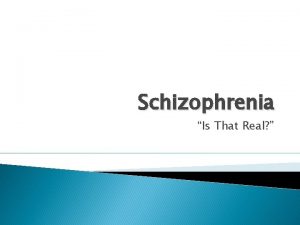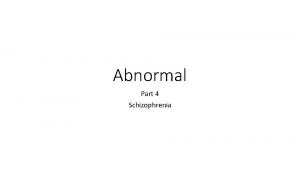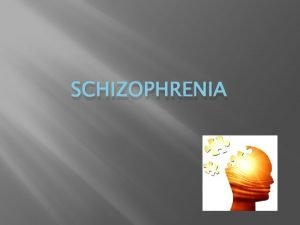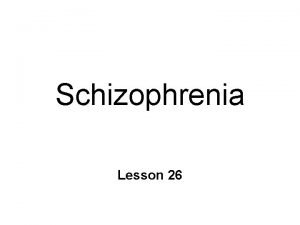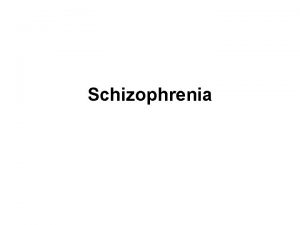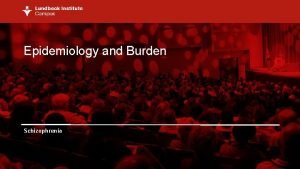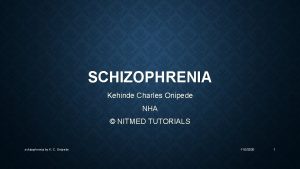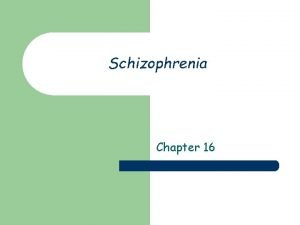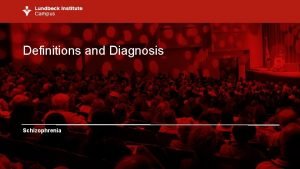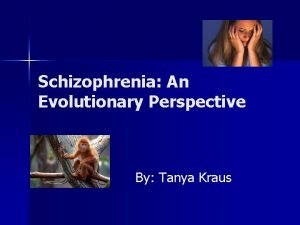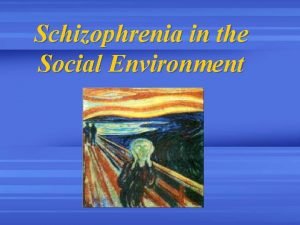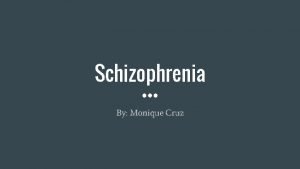The Science of Schizophrenia Dr Stephen M Stahl


































- Slides: 34

The Science of Schizophrenia Dr. Stephen M. Stahl Healthy bodies, healthy lives LAT 500 -15 revised February 2016

Learning Objectives ► To learn about neuroregulation of schizophrenia symptomatology ► To understand current hypotheses of schizophrenia and how they influence treatment ► To become familiar with the focus of current research on treatment and management of schizophrenia 2

Outline 1. The neuroanatomy and neurotransmitter pathways of schizophrenia 2. Neuromodulation underlying the pathology and treatment of schizophrenia 3. Frontiers in schizophrenia research 3

Facts and Figures of Schizophrenia 5 per 1000 adults aged 16 to 741 ££ ££ £ £ § 33% had been homeless § 13% had been roofless 4 Cost of mental illness to the UK economy: £ 70 to £ 100 billion per year 2 Account for 2% of the prison population, 4 x that of the general population 5 Rate of employment for people with schizophrenia: 10 – 20%3 Mortality rate 2. 5 times greater than the general population 6 1 Singleton et al. Psychiatric Morbidity Among Adults Living in Private Households. London, UK: Office of National Statistics; 2001. Report of the Chief Medical Officer 2013, Public Mental Health Priorities: Investing in the Evidence. London: Department of Health https: //www. gov. uk/government/uploads/system/uploads/attachment_data/file/413196/CMO_web_doc. pdf. Published September 2014. Accessed April 2015. 3 Marwaha and Johnson. Soc Psychiatry Psychiatr Epidemiol. 2004; 39(5): 337 -49. 4 Bebbington et al. Soc Psychiatry Psychiatr Epidemiol. 2005; 40(9): 707 -17. 5 Singleton et al. Psychiatric Morbidity Among Prisoners: Summary Report. London, UK: Office of National Statistics; 1998. 6 Saha et al. Arch Gen Psychiatry. 2007: 64(10): 1123 -31. 2 Davies, S. C. Annual 4

Symptom Domains, Clinical Features and Neuroanatomy of Schizophrenia Positive Symptoms • Hallucinations • Delusions • Disorganised speech & behaviour Mesocortical circuits Negative Symptoms Mesolimbic Frontal cortical circuits Nucleus accumbens • • Blunted affect Emotional withdrawal Poor rapport Passivity Cognitive Symptoms Amygdala Difficulties with: • Attention • Problem solving • Working memory • Speed of processing Affective Symptoms • • • Depressed mood Anxious mood Guilt Tension Irritability Worry Aggressive Symptoms • Verbal or physical abuse • Self-injurious behaviour • Destructive behaviour (arson, property damage) Stahl SM. Stahl’s Essential Psychopharmacology, Cambridge University Press. 2013. 5

Neurotransmitter Systems Involved in the Pathology and Treatment of Schizophrenia Glutamate Dopamine NMPA receptor AMPA receptor kainate receptor D 1 D 2 D 3 D 4 D 5 Serotonin 5 -HT 1 A metabotropic receptor GABA -aminobutyric acid 5 -HT 2 A 5 -HT 2 C 5 -HT 3 5 -HT 6 5 -HT 7 GABAA receptor GABAC GABAB receptor Stahl SM. Stahl’s Essential Psychopharmacology, Cambridge University Press. 2013. 6

Dopamine Pathways in the Brain nigrostriatal mesolimbic Striatum PFC NA T HY mesocortical SN tuberoinfundibular P VTA thalamic Stahl SM. Stahl’s Essential Psychopharmacology, Cambridge University Press. 2013. 7

The Dopamine Hypothesis of Schizophrenia • Stimulant drugs such as amphetamine or cocaine release dopamine • Repeated administration cause a paranoid psychosis that is indistinguishable from the positive symptoms of schizophrenia 1 Striatum PFC NA T HY SN P VTA • All known antipsychotic drugs capable of treating positive symptoms antagonise the dopamine D 2 receptor 1, 2 • Chlorpromazine and haloperidol first prescribed in the 1950 s and 60 s 1 Stahl SM. Stahl’s 2 Bennett MR. J Essential Psychopharmacology, Cambridge University Press. 2013. Psychopharmacol. 1998; 12(3): 289 -304. 8

The Dopamine Hypothesis of Schizophrenia Striatum PFC NA positive symptoms SN negative symptoms VTA Hyperactivation of both the mesolimbic and nigrostriatal pathway is thought to underlie the positive symptoms of schizophrenia Hypoactivation of the mesocortical pathway is thought to underlie both the negative and cognitive symptoms of schizophrenia cognitive symptoms Stahl SM. Stahl’s Essential Psychopharmacology, Cambridge University Press. 2013. Kegeles et al. Arch Gen Psychiatry. 2010; 67(3): 231 -239. 9

Glutamate Pathways in the Brain cortico-brainstem cortico-striatal Striatum PFC NA ventral hippocampus to nucleus accumbens T thalamo-cortical NT cortico-thalamic cortico-cortical Stahl SM. Stahl’s Essential Psychopharmacology, Cambridge University Press. 2013. 10

The Glutamate Hypothesis of Schizophrenia • Treatment with glutamate receptor (NMDA) antagonists ketamine or phenylcyclidine (PCP) causes symptoms of schizophrenia in healthy volunteers • NMDAR antagonists worsen symptoms in schizophrenia patients Striatum PFC NA T NT • Genetic abnormalities of glutamate signalling have been found in patients with schizophrenia • Hypofunctional glutamate receptors seen in individuals with schizophrenia Stahl SM. Stahl’s Essential Psychopharmacology, Cambridge University Press. 2013. 11

The Glutamate Hypothesis of Schizophrenia Striatum PFC NA positive symptoms Hypoactivation of NMDA receptors on cortical interneurons can lead to hyperactivation of the mesolimbic dopamine pathway VTA Stahl SM. Stahl’s Essential Psychopharmacology, Cambridge University Press. 2013. 12

The Glutamate Hypothesis of Schizophrenia Striatum NA GP positive symptoms Hypoactivation of NMDA receptors in the ventral hippocampus can lead to hyperactivation of the mesolimbic dopamine pathway VTA Stahl SM. Stahl’s Essential Psychopharmacology, Cambridge University Press. 2013. 13

The Glutamate Hypothesis of Schizophrenia Hypoactivation of NMDA receptors on cortical interneurons can lead to hypoactivation of the mesocortical dopamine pathway PFC negative symptoms VTA cognitive symptoms Stahl SM. Stahl’s Essential Psychopharmacology, Cambridge University Press. 2013. 14

Summary 1: The neuroanatomy and neurotransmitter pathways of schizophrenia § Positive symptoms of schizophrenia result from the hyperactivation of both the mesolimbic and nigrostriatal dopamine pathways § Negative and cognitive symptoms result from the hypoactivation of the mesocortical dopamine pathway § Glutamatergic dysregulation of dopamine pathways may underlie the symptoms of schizophrenia 15

Outline 1. The neuroanatomy and neurotransmitter pathways of schizophrenia 2. Neuromodulation underlying the pathology and treatment of schizophrenia 3. Frontiers in schizophrenia research 16

Excitatory Cells and Inhibitory Interneurons are Key Mediators of Information Processing Interneurons mediate signals between… Excitatory Glutamatergic Pyramidal Cell Pyramidal cells Inhibitory GABAergic Interneurons Chandelier Cells Basket Cells Pyramidal cell + Neuromodulators Neuromodulator Both pyramidal cells and interneurons express many different neurotransmitter receptors: Dopaminergic Noradrenergic Serotonergic Cholinergic Stahl SM. Stahl’s Essential Psychopharmacology, Cambridge University Press. 2013. 17

Cortical 5 -HT 2 A Receptors Decrease Dopamine Release Prefrontal Cortex 5 -HT 2 A Striatum PFC NA NT Brainstem Neurotransmitter Centre Stahl SM. Stahl’s Essential Psychopharmacology, Cambridge University Press. 2013. 18

Cortical 5 -HT 1 A Receptors Increase Dopamine Release Prefrontal Cortex Striatum PFC 5 -HT 1 A NA NT Brainstem Neurotransmitter Centre Stahl SM. Stahl’s Essential Psychopharmacology, Cambridge University Press. 2013. 19

Stimulation of 5 -HT 7 Receptors in the PFC Reduces Glutamate Release Prefrontal Cortex 5 -HT 7 PFC NT Brainstem Neurotransmitter Centre Stahl SM. Stahl’s Essential Psychopharmacology, Cambridge University Press. 2013. 20

Differential Effects of 5 -HT Receptors in the Brain Activation 5 -HT 2 A 5 -HT 1 A 5 -HT 7 Decreases Dopamine Increases Dopamine Decreases Glutamate Inhibition Increases Dopamine Decreases Dopamine Increases Glutamate Stahl SM. Stahl’s Essential Psychopharmacology, Cambridge University Press. 2013. 21

Current Mechanism of Action of Antipsychotics Drugs Almost all currently approved drugs for the treatment of schizophrenia target only the positive symptoms Amisulpride is currently the only approved drug indicated for the treatment of patients with predominantly negative symptoms (and only in Europe) There are no approved agents that treat cognitive symptoms of schizophrenia Pharmacology Conventional Antipsychotics ►Dopamine D 2 Receptor Antagonists ►Dopamine Atypical Antipsychotics D 2 Receptor Antagonists ►Serotonin 5 -HT 2 A Receptor Antagonists Farah A. Prim Care Companion J Clin Psychiatry. 2005: 7(6): 268 -274. MHRA Public Assessment Report for Amisulpride Adverse Side Effects ►Extrapyramidal symptoms ►Hyperprolactinemia ►Metabolic side effects (weight gain, glucose dysregulation, dyslipidemia) 22

Development of Novel Medications for the Treatment of Schizophrenia Most of the current drug development research in schizophrenia is focused on agents that can improve negative and/or cognitive symptoms Glutamate-based targets m. Glu 2/3 agonists ►Pomaglumetad methionil for the treatment of negative symptoms ►Investigation terminated NMDAR agonists ►Glycine, D-serine, D-cycloserine ►Glycine and D-serine due to lack of efficacy in clinical trials show promising results as adjunctive therapy GLTY 1 inhibitors ►Investigated as adjunctive therapies ►Sarcosine as a primary antipsychotic agent ►Bitopertin for the treatment of negative and positive symptoms Cholinergic-based targets Nicotinic 7 agonists ►Encenicline for the treatment of cognitive symptoms ►Promising phase 2 results Citrome L. 2014. J Clin Psychiatry. 75 (Suppl 1): 21 -26. 23

Acetylcholine Receptors are Widely Expressed in the Brain and are Important for Cognition In both animal models and patients with schizophrenia, treatment with 7 agonists resulted in improvements in working memory and attention 2 PFC BF Deficits in sensory gating, a biomarker for cognitive function, are linked to variants in the 7 receptor gene locus 3, 4 T A HY H Cholinergic neurons project from both the brainstem and the basal forebrain 1 NT Postmortem studies of patients with schizophrenia show a decreased expression of 7 receptors in the frontal cortex 5 1 Stahl SM. Stahl’s Essential Psychopharmacology, Cambridge University Press. 2013. Rev Neurobiol. 2007; 78: 225 -246. 4 Leonard et al. Arch Gen Psychiatry, 2002; 59: 1085 -90. 3 Freedman et al. Proc Natl Acad Sci USA. 1997; 94(2): 587 -92. 5 Guan et al. Neuroreport. 1999; 10(8): 1779 -82. 2 Martin LF and Freedman R. Int 24

Summary 2: Neuromodulation underlying the pathology and treatment of schizophrenia § Interaction between excitatory glutamatergic cells and inhibitory GABAergic interneurons plays a key role in the symptomatology of schizophrenia § Serotonergic regulation of dopamine is vital to the efficacy of atypical antipsychotics § Current drug development efforts are focused on the negative and cognitive symptoms of schizophrenia 25

Outline 1. The neuroanatomy and neurotransmitter pathways of schizophrenia 2. Neuromodulation underlying the pathology and treatment of schizophrenia 3. Frontiers in schizophrenia research 26

Genetics of Schizophrenia What Has the Research Told Us About the Nature of the Disease? ►Linkage analysis ►Positional cloning ►Candidate gene analysis 1, 2 1960 s & 1970 s RGS 4 DISC 1 DTNBP 1 STX 7 TAAR 6 PPP 3 CC NGR 1 DRD 2 HTR 2 A DAOA AKT 1 CHRNA 7 COMT ARVCF 1980 s – 2000 s Family, twin, and adoption studies showed there was a clear genetic component to the disease 1 2014 The genetics of schizophrenia is more complicated than once thought and highlights the complexity of the overall disease state Schizophrenia Working Group of the Psychiatric Genomics Consortium Multi-stage GWAS 4: ► 36, 989 cases/113, 075 controls ► 128 independent associations over 108 different loci Bull. 2011; 37(3): 456 -463. J Psychiatry. 2008; 165: 497 -506. 3 Allen et al. Nat Genet. 2008; 40(7): 827 -834; www. szgene. org 4 Schizophrenia Working Group of the Psychiatric Genomics Consortium. Nature. 2014; 511(7510): 421 -7 SZ Gene Database 3 (Schizophrenia Gene) ► 1727 Studies ► 1008 Genes ► 8788 Polymorphisms ► 287 Meta-analyses 1 Kim et al. Schizophr 2 Sanders et al. Am 27

Pharmacogenetics of Antipsychotic Drug Response Using genetics to predict efficacy and susceptibility to adverse drug reactions § Individual treatment response to antipsychotic drugs is highly variable § Many patients do not achieve a sufficient therapeutic response § Many patients experience a high degree of adverse drug reactions that often results in treatment discontinuation Efficacy Genes Pharmacokinetic Genes § Functional polymorphisms in the DRD 2 promoter shown to significantly influence antipsychotic drug efficacy § Results have yet to achieve both adequate sensitivity and specificity to reliably guide clinical practice § The cytochrome P 450 gene CYP 2 D 6 is a major metaboliser of several antipsychotic drugs § Many of the over 100 genetic variants found for CYP 2 D 6 result in reduced enzymatic activity § Diagnostic tests for CYP 2 D 6 variants are commercially available Malhotra et al. Mol Psychiatry. 2012; 17: 760 -769. Zhang JP and Malhotra AK. Expert Opin Drug Metab Toxicol. 2013: 9(2): 183 -191. Adverse Drug Reaction Genes § Candidate genes for antipsychotic-induced weight gain include DRD 2, HTR 2 C, GNB 3, and MC 4 R § Various HLA markers have consistently been shown to be associated with clozapine-induced agranulocytosis (CIA) DRD 2: Dopamine D 2 receptor HTR 2 C: 5 -HT 2 C receptor; GNB 3: Guanine nucleotide binding protein, beta polypeptide 3; MC 4 R: Melanocortin 4 receptor HLA: Human leukocyte antigen 28

Pathophysiology of Schizophrenia: Knowledge Gained from Imaging Studies Parietal Lobe Frontal Lobe ► Reduced volume ► Reduced superior parietal ► Reduced grey and white matter volume ► Reduced DLPFC, OFC, and dorsomedial regions ► Lower density of dendritic spines of postsynaptic neurons ► Hypofrontality and hyperfrontality in the DLPFC ► Reduced activity in VLPFC, RVPMC, and RDACC during cognitive challenge gyrus, inferior parietal lobe and supramarginal gyrus ► Reduced activation during cognitive challenge Occipital Lobe ► Reduced grey matter in visual association area (VAA) ► Reduced grey matter volume Temporal Lobe Both structural and functional abnormalities are seen throughout the brain in patients with schizophrenia ► Reduced hippocampus, parahippocampal gyrus, superior temporal gyrus ► Reduced density of dendritic spines ► Reduced/abnormal activation of left middle temporal gyrus, bilateral amygdala, parahippocampus, and fusiform gyrus during emotion perception Ahmed et al. Curr Psychiatry Rep. 2013; 15(3): 345. Onitsuka et al. 2007. Schizophr Res. 2007; 92: 197 -206. 29

Current Overarching Mechanism-of-Disease Hypothesis Environmental Factors 1 ► Prenatal infection/ immune activation ► Paternal age ► Malnutrition ► Hypoxia-related obstetric complications ► Childhood/adolescence social stress ► Cannabis abuse Neurochemical Abnormalities 3 ► Dopamine imbalance ► Glutamate receptor hypofunction ► Reduced GABA expression Neurodevelopmental Deficiencies 2 Genetic Factors 1 ► Degree of heritability ► Associated genetic variants 1 Jiang et al. Front ► Reduced grey matter ► Reduced white matter ► Deficient myelination ► Reduced interneuron activity ► Excessive excitatory pruning Behav Neurosci. 2013; 7: 116. 2 Insel TR. Nature. 2010; 468: 187 -193. 3 Stahl SM. Stahl’s Essential Psychopharmacology, Cambridge University Press. 2013. 30

Future Research Directions for the Treatment and Management of Schizophrenia ►Cognitive impairment is seen in nearly every patient with schizophrenia Cognitive Impairment in Schizophrenia 1 ►Deficits are significant and broad in nature ►Deficits appear early in the course of the disease and continue throughout the lifetime of the disease ►An individual’s level of cognitive function is strongly related to their functional outcome ►Symptoms present in adolescence and early adulthood Early Detection and Treatment Intervention 2 ►The disease course is characterised by recurrent exacerbation and remissions in a chronic state of residual symptoms and functional impairment ►Meager treatment responses and outcomes are associated with a longer duration from the initial episode of the illness prior to treatment intervention 1 Tandon et al. Schizophr Res. 2009; 110(1 -3): 1 -23. 2 Liberman et al. JAMA. 2013; 310(7): 689 -90. 31

Summary 3: Frontiers in schizophrenia research § The genetics of schizophrenia are much more complicated than once thought § A complex interplay of genetics, environmental factors, and defects in both neurodevelopment and in neurotransmitter systems is thought to underlie schizophrenia § The future direction of treatment focuses on both cognitive impairment and early detection and intervention 32

Latuda® (lurasidone) Prescribing Information s. P yl ema ps te o m i cu mmma al ri yg no af n Pt r os dy un cd t r o r es f e or f t on e t uh re o fl ue l pl t S C m h ae r. a c. C t oe nr is si t di e c sr d t ienf ao ur et i op nr e is f c rs i i bg i nn sg , o p f at ri dc iu vl e e a ar d. v e. Mr a y ( Si s. P c. Co) n b a r d l yy si kn i nr e ls ai ta i oa np pt o s e e e r eu cn a du et ir ol ny si n agn dp ac or kn ti rn as i on d n ii cs amt i os ny sm. P p tr oe m s n. t Ra it si ok n os f: r ex aa c ct e i or nb sa, t p s e e x t ur ad p s d y mt pa tb ol em t ss. , C s L a a y f r i al m -i cd oa al t e c oa nu tt ai o i nn i nagn dl u rc al is ni di co an le m h yo dn ri ot oc rh il no gr i di e re eq cu oi m a m t i ge , n t 3 s 7 . w 2 i m t hg aa n h d i s 7 t 4 o. r 5 y m og f l su er i az su i rd eo s n eo. r v am l ee nn dt e td o i 1 n 8 p. 6 c. I n o nd di ic t ai ot n p a o t ei sn t ii na dl l i yc ar te ed du c f eo r s et ih ze u rt er e t ah t r me es h d f, i os n w: h. L i ac th u d n ot l o cs ac r hd ii oz vo aps hc ur le a nr i da i s io nr d ea r ds u, l ot r st h o( s≥ t 1 a 8 t i c y he yap ro st e) n. s Di oo n s, ad i ga be e t ea s n odr r. A i ds m k i f na ic st ot r sa t f i oor n d. Fi oa rb eo t reasl aa nd dm i wn ei si gt rh at t g i n A. d. Mu al yt s e: l Re ve ac t oe m pmr oe l na dc te i dn i oa n: ls et av re tl i sn. g A dl ol s rei : s k 3 7 f m a cg t o n r sc e f od r a i vl ey n w o iu t sh t ah r mo emabl o. e Nmob oi nl ii st ima l ( Vd T o s. E e) st i ht ro au t li d d f f be ec ft io v r ee d ao ns ed r da un rg ie n: g 3 7 t r t eo a 1 t 4 m 8 emn g t o an nc de o n b i es ri ed qe un i tr ie fd i. e E p t ao ku el nd. b Ce a u d ra ei lv ye. n t. Da ot si ve e i m n ce ra es au sr ee s s h b ta i so en d i n o n p ap th i ye sn i t cs i awni t jh u da g feammei nl yt h r ys e or vf e Q r oi cl ao ln gr ea st pi oo n s, e h. y Mp ao xk i aml ua m e md i oas ea: n 1 d 4 8 c m o ng c po emr i td aa ny t. a ni sd t o b d T c l pi n m t i (o≥n 6 5 k n yo ewanr st )o : p. Cr ao ul ot in og n t w h eh e Qn T t ri ne ta et ri vn ag l . w i. Ct l ho sh ei lgyh es ru pdeor sv ei s e. E le dd ei cr al y h s kn pa an t di e a n td so lf eo sr c r ei sn kt s o (f < s 1 u 8 i c yi ed e C i hg i hl dr ri e a. r s. A) v: o i. Nd o tg r ra ep ce of rmu mi t e nj ud i ec de , . P e sr es s ar e f eg tny a na cn yd ae nf fd i cl aa cc yt a nt oi ot n e: s. Dt oa bn l oi ts hu es de. d u. Dr oi ns ge pa r de j gu nsat nmc ey n ut sn l a p g h tl o i m t hpea if ro me et un st , . r eo qt eu ni rt ei ad l i bn e n m eo f di et r ca l t ee a ra l ny d o su et w v ee ri e hs e pp oa tt ei cn t ai an ld r ri es nk a B f e Ce d if nog r s hf ou ur l td h bee r c od nes ti da ei r l e sd. o Cn loy n i ft rt ha e i pn o dt ei n ct i aa lt ib eo n ne fs i t: s re e ea s t. S P o t r ee ra st e m ne sn ti t j i uv si t t i yf i et so t th he e p o c it ei on nt ss. : H fy p a tc et ni tv i ea l s r ui sb ks tt ao n t ch ee co hr i l ad n. Iy n et ex rc ai p C a n i ti sa n at d a v id sme i dn iws ht er an t ic oo nm bo i f n isnt gr o wn i gt h C a. Y l. Pc 3 o Ah 4 o l i o e o un tc i oo m n rh i Cb N i t So ras c tai nv d m a tr is o. n Ws , a ra nn id n m e d a i cni d n e P s r ken co aw un t it oo nc sa : u C s el i n. Q i Tc ap l r oi lmo pn rg oa vt ei omne; n Pt i nedd ui c e g s -mgapy a t na dk e. B Ca R s ia dt oi en n e t, f. Pe wi n h d ia by i st o t r os smoa my e i nwcer ee ka ss ; e ce l xo ps oe sl uy r em ot on i lt uo rr a p ld uu rr ai ns gi d b i w t oi tr h o S t. Ps C w fi ot hr toh ni es pi se r ai on d . i n Uh si e cf a P u t- igopn ai n d e l. Bd Ce R r l. Py , p sa et ei e n d e m t ae i nl ts i. a Dw oh so e h aa dv je u rs i t smk e fnat c ti os r sr e f co or m s mt re onk de e. d N io nt sc to umd bi ei nd a i t ni o enl d we ir tl hy C p a t i e. Y n t s Pw i t h 3 d e m. A e n t i 4 a. D i s c oi n t i n u e hi f p ai t i e nb t d ei v e l to p s o s i g nr s o rs 33

Latuda® (lurasidone) Prescribing Information and inducers, see SPC for details. Monitoring recommended when lurasidone and CYP 3 A 4 substrates known to have a narrow therapeutic index are coadministered. Undesirable effects: In clinical trials, the following adverse drug reactions were reported: very common (≥ 10%): akathisia, somnolence; common (≥ 1% to <10%): weight increased, insomnia, agitation, anxiety, restlessness, parkinsonism, dizziness, dystonia, dyskinesia, nausea, vomiting, dyspepsia, salivary hypersecretion, dry mouth, upper abdominal pain, stomach discomfort, musculoskeletal stiffness, blood creatinine phosphokinase increase, serum creatinine increase, fatigue; uncommon (≥ 0. 1% to <1%): decreased appetite, blood glucose increased, catatonia, tardive dyskinesia, tachycardia, hypertension, hypotension, alanine aminotransferase increase, blood prolactin increased; rare (≥ 0. 01% to <0. 1%): eosinophilia, rhabdomyolysis, neuroleptic malignant syndrome (NMS). This is not a complete list of adverse reactions. Prescribers should consult the SPC in relation to all adverse reactions. Special precautions for storage: Store in the original package in order to protect from light. Special precautions for disposal and other handling: Any unused medicinal product or waste material should be disposed of in accordance with local requirements. Legal classification: Prescription Only Medicine (POM). Package Quantities and Basic NHS Costs: Latuda 18. 5 mg, 37 mg and 74 mg £ 90. 72 per pack of 28 tablets. Marketing Authorisation Holder: Sunovion Pharmaceuticals Europe Ltd, Southside, 97 – 105 Victoria Street, London, SW 1 E 6 QT. Latuda is a registered trade mark. Marketing Authorisation Number(s): EU/1/14/913/001 -021. Date of Preparation: February 2016 (MI-LAT-000781). This medicinal product is subject to additional monitoring. This will allow quick identification of new safety information. Healthcare professionals are asked to report any suspected adverse reactions Adverse reactions should be reported. Reporting forms and information can be found at www. mhra. gov. uk/yellowcard Adverse reactions should also be reported to Sunovion Pharmaceuticals Europe Ltd. on 020 7821 2899 Date of preparation: September 2014. UK/LUR/14/0188 a 34
 The most beautiful experiment in biology
The most beautiful experiment in biology En que fase se da el crecimiento de la celula
En que fase se da el crecimiento de la celula Henthorn v fraser
Henthorn v fraser Jorge stahl
Jorge stahl Experimento de meselson y stahl
Experimento de meselson y stahl Croset cervico alveolar deschis dental
Croset cervico alveolar deschis dental Shock class
Shock class Benedicta stahl sodré
Benedicta stahl sodré Stahl meaning
Stahl meaning Meselson and stahl's experiment
Meselson and stahl's experiment Wärmeübergangskoeffizient stahl luft
Wärmeübergangskoeffizient stahl luft Längenausdehnung stahl feuerwehr
Längenausdehnung stahl feuerwehr Jean-paul stahl
Jean-paul stahl Stahl
Stahl Stahl
Stahl Scott stahl make a wish
Scott stahl make a wish Stahl index
Stahl index Stahl bezeichnung
Stahl bezeichnung Stahl electronics
Stahl electronics Antiparallel
Antiparallel Achim stahl
Achim stahl What is your favorite subject what subject
What is your favorite subject what subject Stephen oluwole awokoya foundation
Stephen oluwole awokoya foundation A new kind of science
A new kind of science Hát kết hợp bộ gõ cơ thể
Hát kết hợp bộ gõ cơ thể Ng-html
Ng-html Bổ thể
Bổ thể Tỉ lệ cơ thể trẻ em
Tỉ lệ cơ thể trẻ em Voi kéo gỗ như thế nào
Voi kéo gỗ như thế nào Tư thế worms-breton
Tư thế worms-breton Hát lên người ơi alleluia
Hát lên người ơi alleluia Các môn thể thao bắt đầu bằng tiếng đua
Các môn thể thao bắt đầu bằng tiếng đua Thế nào là hệ số cao nhất
Thế nào là hệ số cao nhất Các châu lục và đại dương trên thế giới
Các châu lục và đại dương trên thế giới Cong thức tính động năng
Cong thức tính động năng
